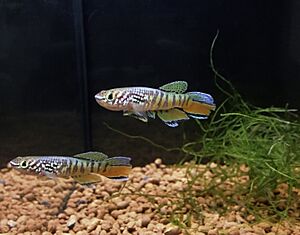Blue gularis facts for kids
Quick facts for kids Blue gularis |
|
|---|---|
 |
|
| Male in an aquarium | |
| Conservation status | |
| Scientific classification | |
| Genus: |
Fundulopanchax
|
| Species: |
sjostedti
|
 |
|
| Synonyms | |
|
|
The blue gularis is a special type of fish also known as the golden pheasant gularis or red aphyosemion. Its scientific name is Fundulopanchax sjostedti. This fish is a kind of toothcarp, which means it's a small, freshwater fish.
It lives only in a specific area of Africa. You can find it in the Niger delta, which is a large river system. This fish lives in the countries of Nigeria and Cameroon.
Meet the Blue Gularis!
The blue gularis fish was named after a Swedish scientist named Bror Yngve Sjöstedt. He was the first person to collect and describe this fish. He found it near a waterfall by the Ndian River in Cameroon in 1895.
What Does It Look Like?
Blue gularis fish are known for their beautiful colors. The males and females look different, which is called sexual dimorphism. Male blue gularis fish are much more colorful and bigger than the females. They have very attractive patterns and bright colors.
These fish are the largest in their group, called Fundulopanchax. They can grow up to about 14 centimeters (or 5.5 inches) long. Even though they are big for their group, they are not the biggest killifish overall. For example, the Gulf killifish can grow even longer, up to 18 centimeters (7 inches).
What Does It Eat?
The blue gularis is a strong and active fish. It likes to hunt for its food. It mainly eats small bugs and other tiny creatures without backbones, which are called invertebrates. It also sometimes eats smaller fish.
Why Is It Special?
The blue gularis is listed as an Endangered species. This means there are not many of them left in the wild. It's important to protect their homes and make sure they can continue to live and thrive.


